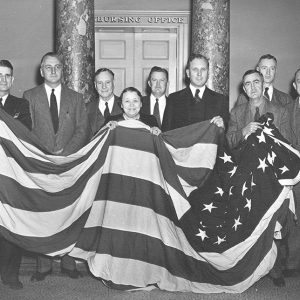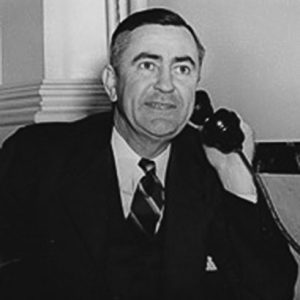calsfoundation@cals.org
George Lloyd Spencer (1893–1981)
George Lloyd Spencer, a Democrat, served as U.S. senator of Arkansas from April 1, 1941, to January 3, 1943, filling the vacancy left by the resignation of Senator John E. Miller. Spencer was not elected to a full term in office but served the remainder of Senator Miller’s term. Spencer also served in the U.S. Navy during both World War I and World War II.
George Spencer was born on March 27, 1893, at Sarcoxie, Missouri, to George Spencer and Louella Riley Spencer. He moved to Okolona (Clark County) in 1902, where he attended public school. He also attended Peddie Institute at Highstown, New Jersey, and Henderson-Brown College in Arkadelphia (Clark County). In 1918, Spencer served as a seaman, second class in the navy during World War I.
Spencer married Florence Hays of Okolona in 1919 and moved to Hope (Hempstead County) in 1921, where he engaged in banking and farming. The couple had two sons. Spencer became a prominent member of the Arkansas banking community, serving as cashier of the Hope Savings Bank and Trust Company and Hope National Bank, which were combined to become the First National Bank of Hope. He was appointed president of the bank in 1938. Upon becoming president, he said, “No bank I have ever been deeply associated with has ever failed and no one has ever lost a cent in one of them.” In 1939, he was chosen as president of the Arkansas Bankers Association.
Spencer was appointed U.S. senator by Governor Homer M. Adkins in 1941 to fill the vacancy of incumbent Senator John E. Miller. Miller resigned after being appointed a federal judge by President Franklin D. Roosevelt. Spencer served as U.S. senator from April 1, 1941, until January 3, 1943. During his time as senator, Spencer served on the Post Office Committee, Claims Committee, Bureau of Banking and Currency Committee, and War Plant Inspection Committee. Spencer was succeeded in office by John L. McClellan.
Spencer was one of the directors of an endeavor by the American Legion at Hope to provide for U.S. Army soldiers during large-scale maneuvers held in southern Arkansas and Louisiana. Spencer returned to Hope from Washington DC to assist in the project, in which the American Legion provided cold drinking water, soft drinks, and free showers to thousands of soldiers. The project also initiated a post office where soldiers were able to mail letters and postcards to family and friends. Approximately 40,000 troops were served by the American Legion at Hope.
Spencer served as lieutenant commander in the U.S. Naval Reserve from 1931 to 1943, and in 1943, he served again in the navy during World War II.
In 1965, Spencer was elected as chairman of the First National Bank’s board of directors and served as chairman until he retired in 1977, after which he continued to act as adviser to the bank’s board until his death.
He was also a member of the board of directors of the Southwest Arkansas Water District and Hope Water and Light Commission, president of the Red River Valley Association, member of the board of directors of the Federal Reserve Bank of St. Louis, member of the board of directors of Arkansas Louisiana Gas Company, and member of the official board of the First United Methodist Church.
Spencer died on January 14, 1981, in Hope. He is buried at Rosehill Gardens in Hope.
For additional information:
“George Lloyd Spencer.” Biographical Dictionary of the United States Congress. http://bioguide.congress.gov/scripts/biodisplay.pl?index=S000724 (accessed January 24, 2022).
“Southwestern Proving Ground Officers Quarters Historic District, Oakhaven, Hempstead County.” National Register of Historic Places Nomination Form. On file at Arkansas Historic Preservation Program, Little Rock, Arkansas. Online at http://www.arkansaspreservation.com/historic-properties/_search_nomination_popup.asp?id=845 (accessed January 24, 2022).
Jaci Manning
Little Rock, Arkansas
 Politics and Government
Politics and Government World War II Ordnance Plants
World War II Ordnance Plants Senators and Representative: 1938
Senators and Representative: 1938  Lloyd Spencer
Lloyd Spencer 



Comments
No comments on this entry yet.